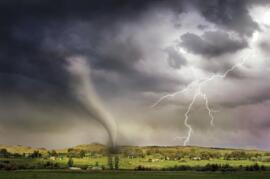
Mackle has never seen a tornado in person, but he has seen it in some movies on TV. Most of clips were fictional: roofs were ripped off; and trees were uprooted and rotated in the air like ice-cream cones. As the 'Giant Monster', which wasn't as cute as the ice cream, was coming at him, Mackle scared, trying to run, but he couldn't move. Such a terrible scene disappeared after he struggled for a while.
It turned out to be a dream.
As a child, Mackle recovered soon after being awakened by such a nightmare. He begun to think about a question: how did the empty and silent ground produce such a big tornado? He was not only curious about why he would make such a dream, but also about the real nature.
How does the tornado come into being? Let us leave the dreams and talk about why there is a tornado first.
In fact, a tornado does not take shape at one blow. There is a process for its accumulation. It usually starts with thunderstorms. They produce intense winds, lightning, hail and even floods. All these will help to spawn tornadoes. When the water vapor in the upper air condenses to a certain extent, a storm will be formed. It causes an upward airflow. However, the rising airflow does not go along a line as we expected. It may be affected by various factors during this process, including the surrounding wind and turbulence. This makes the rising airflow start to spin. As a result, a vortex-like airflow is formed. We name it as 'cyclone'. The cyclone at this stage is a moderate cyclone called mesocyclone. As it stretches upward and downward, it becomes narrower and gets more energy. At the same time, a small cluster of energy is strengthening inside the cyclone. This is the primary form of a tornado, and also the core of it. The rotation of a primary tornado is different from that of a cyclone in many aspects, such as speed and energy. When a primary tornado keeps rotating, it will continue to extend downward to the ground and upward to the sky. Once it reaches the ground, the air pressure on the ground will drop sharply, and the wind speed on the ground will rise sharply. Then, a tornado is formed.
Most tornadoes are small and will not last for a long time. Tornadoes usually rotate extremely fast with a wind speed of 50 to 150 meters per second. A few of them can exceed the speed of 150 meters per second. Generally speaking, tornadoes are only 25 to 100 meters in diameter. Some of them can travel very far to a dozen kilometers away, while others may only travel a few tens of meters. Most tornadoes rotate counterclockwise in the northern hemisphere and clockwise in the southern hemisphere, but there are exceptions.
After a few minutes or a few hours, there will be no temperature difference, the interior of the tornado will be more stable, and the water vapor in the air is drained. The life of the tornado is almost over, and it will disappear. Although tornadoes can't cause long-term damages, they will almost ruin the places they attack. We should not underestimate its destructive power.
Mackle thought, "I'm so lucky that I didn't get caught in a tornado..."
Author: Zhu Yawen

















 京公网安备11010502039775号
京公网安备11010502039775号





